The Dell XPS 13 (9300) Review: Return of the King
by Brett Howse on July 16, 2020 10:00 AM ESTWireless
Dell offers two wireless radio options for the XPS 13, and both are Killer-branded. The default wireless card is the Killer Wi-Fi 6 AX1650, which is a 2x2:2 wireless solution based on the excellent Intel AX200. If somehow you missed it, Intel recently acquired Rivet Networks, so the Killer brand should continue to provide the performance and stability of the Intel adapters for the foreseeable future. Dell also lists a second Killer AX500 Wi-Fi 6 option, but this Killer product is based on the Qualcomm 6390 Wi-Fi 6 chipset. Since Killer has been acquired, that part may not be around for much longer. Our review unit features the Intel-based AX1650.
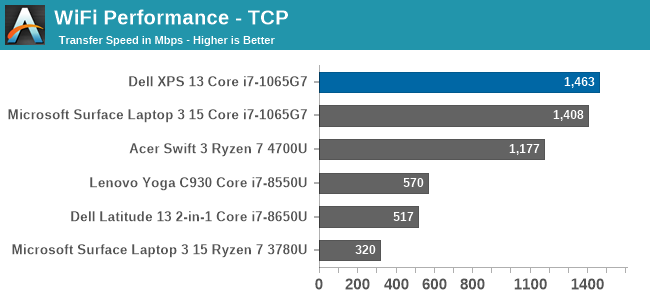
Performance is simply fantastic, and ever since Killer was able to base their network cards on Intel wireless, the stability concerns appear to be a forgotten memory. There was not a single time that the laptop had any issues with its network connection during any of the testing. That was certainly not the case on some of the older Qualcomm-based Killer products.
Audio
Dell offers Waves MaxxAudio Pro stereo speakers, at 2.5 Watts peak each, which are outfitted on the bottom of the laptops right on the edge of the device.
Sound quality is a bit on the tinny side, with not a lot of low end at all. The speaker setup does get quite loud though, with 83 dB(A) measured one inch over the trackpad at maximum volume. There was little to no distortion at peak volume either.
The dual-microphone array is found on the very top of the bezel, which would allow it to work with the device closed. It is a great way to hide the holes, with only the 2.25 mm 720p webcam showing in the bezel itself.
Thermals
Dell outfits the XPS 13 with dual fans and a single heatpipe to cool the 15-Watt Thermal Design Power of the Core processor under the hood. They have added hidden exhaust vents in the hinge, to allow more airflow without compromising the looks. There is also a layer of GORE thermal insulation under the keyboard, which helps keep that portion cool to the touch even under load.
To see how the XPS 13 performs under load, it was run at 100% for an extended period while monitoring the device.
This graph tells an interesting story, unlike most laptops we see. First, Dell has gone absolutely crazy with the PL2 level on the XPS 13, with a peak measurement of a whopping 42 Watts. But, that is not sustainable in a 13-inch laptop, and the CPU throttles in PL2 until it reaches the PL1 limit, which is right at 15 Watts in the XPS 13’s most performant mode. Most of the notebooks we have tested tend to allow a PL1 level above this, with maybe 20-21 Watts as a constant, but Dell clamps to 15 Watts, then spikes back up when the thermals allow, so we see this see-saw effect of the device running between 15 and 30 Watts. This is similar to how the XPS 13 2-in-1 behaved, and it would be nice to see the company address this with a more consistent power delivery under sustained load.
Over the duration of the test, the device averaged 18 Watts of draw, with an average CPU temperature of 80°C, with the four cores running at 2100 MHz. During this extended run, the noise level was very restrained, only hitting around 44 dB(A) measured about one inch over the trackpad. The GORE thermal insulation also did its job, with the keyboard deck remaining cool.
Software
Dell’s included software suite is a very polished set of applications, allowing the user to quickly get the device set up, adjusted, and of course, contact support. As with most manufacturers, they include a utility to get the latest updates, called Dell Update, and that includes some maintenance utilities as well.
Dell’s Power Manager software allows you to change the power profile, as well as adjust the battery charging. The Thermal Management tab allows you to pick a fan and CPU profile, or leave it as the default Optimzed setting which works well for most scenarios.
Dell offers a plethora of battery options to maintain and extend the life of the battery. Out of the box, it comes in an “Adaptive” setting which learns your usage patterns and tries to keep the battery at a good state of charge, but you can override that to keep the battery always at 100% charge in case you need it, or if you mostly use it on AC you can set it to keep the battery to a lower level of charge to prolong its life.
The days of laptops being saddles with an almost unending array of shareware and trial software seem to be mostly over, and even though Dell included Norton with the XPS 13, it can easily be removed if necessary.


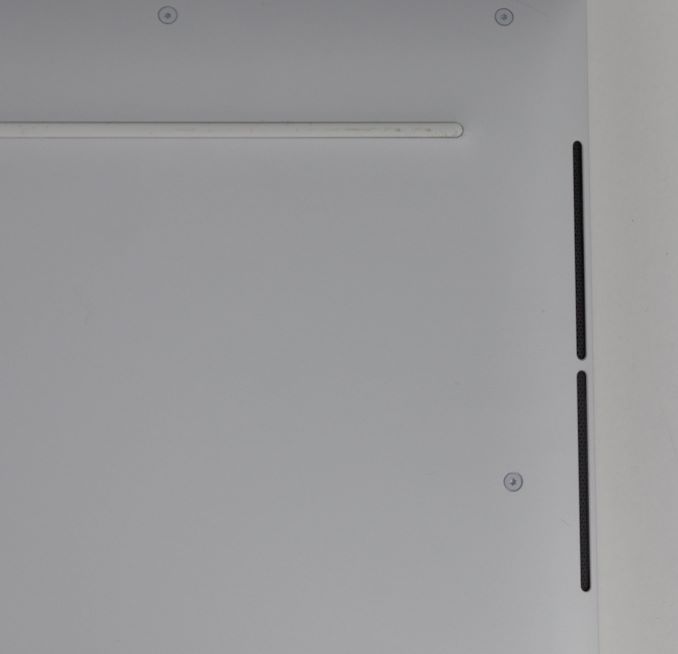
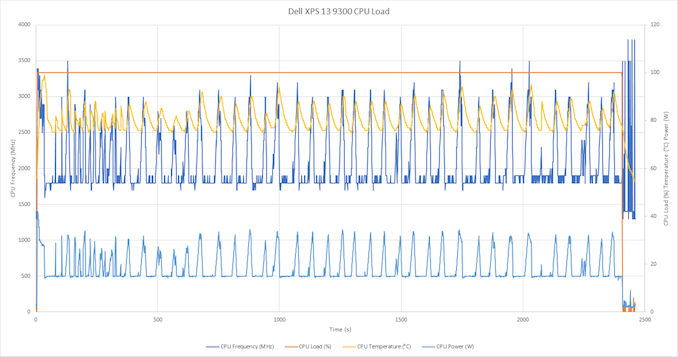
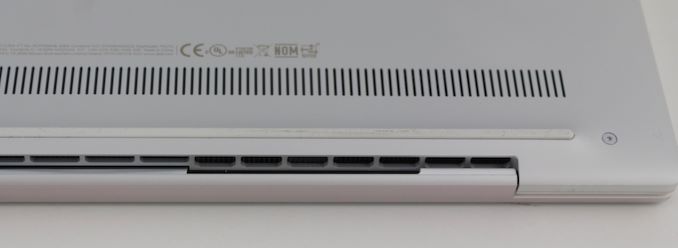

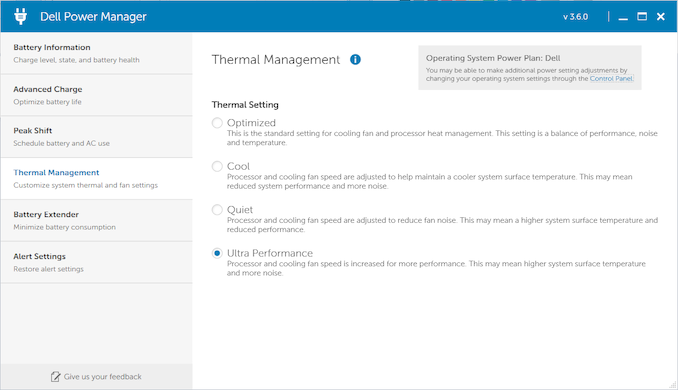
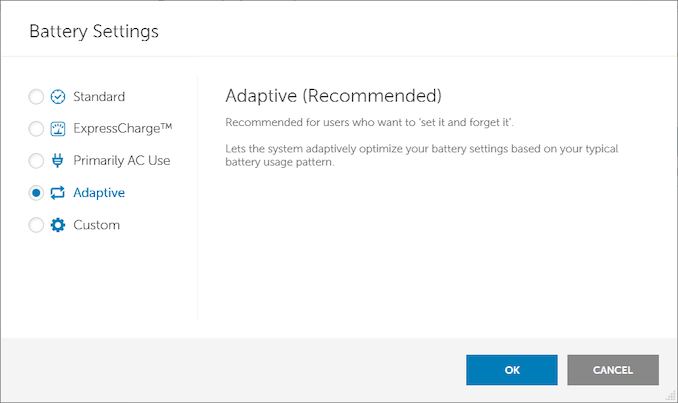








224 Comments
View All Comments
TheinsanegamerN - Thursday, July 16, 2020 - link
If tiger late is as impressive as ice lake the ryzen 4700u will retain a significant advantage in performance, and I'll believe it releases when I see it.Deicidium369 - Thursday, July 16, 2020 - link
Much more impressive. 4C Tiger Lake is 17% slower than 8C Renoir - and Xe LP is at least 2x as fast as Gen11 (in Ice Lake) and performs as well as a Nvidia MX350 (hence why Nvidia is pushing out the Turing MX450) - which wrecks the ancient Vega.So double the cores and a whopping 17% perf advantage - and much slower iGPU - are we sure that AMD understands the laptop market?
rhysiam - Thursday, July 16, 2020 - link
You are doing some gold-standard cherry picking here. Which chart gets you this "17% slower" number you keep quoting as if it's gospel? The 15W thermal envelope is the limiting factor here, so "double the cores" won't net you anywhere near double the performance, nor are they supposed to.According to this very review, lightly threaded tests show the 4700U on par with the similarly clocked Ice Lake. They are neck and neck. IPC is very close between Zen 2 and Sunny Cove.
Highly threaded workloads are dominated by AMD:
CB: 4700U is 52% faster
HB(software): 4700U is 71% faster
HB(hardware): 4700U is 79% faster
7-Zip(comp): 4700U is 34% faster
7-Zip(decomp): 4700U is 40% faster
Remember that the 4700U is **not** the top SKU (though admittedly the 4800U isn't much faster).
Again - where is this "17%" coming from if not deceptively cherry picked?
Tiger Lake looks to have a massive GPU, but what are we looking at CPU wise? A few % IPC and very small clock bump? Maybe Intel squeeze out a tiny single threaded lead, while still getting trashed in multi-core workloads - in exchange for a better iGPU.
Spunjji - Friday, July 17, 2020 - link
@rhysiam - He's basing his claims on an early benchmark leak that does indeed suggest a healthy single-thread lead for Tiger Lake and a moderate multi-core deficit. It doesn't look to be a particularly unreliable leak - apparently comparing like-for-like in terms of chassis - but it's still just the one leak. There are also leaks implying a far less dramatic advantage for the Xe LP GPU, but he's not citing those.When it comes to Deicidium, information suggesting Intel superiority is taken as gospel and information suggesting otherwise is discarded. He spent the months leading up to Renoir's release refusing to believe any of the benchmark leaks favouring AMD and hammering on how unreleased products don't matter. Go figure.
Deicidium369 - Friday, July 17, 2020 - link
Yeah, boy as I wrong - that Great Renoir can compete with an almost year old design! That is unbelievable. With such massive year over year IPC increases - would only be fair to compare the Great Renoir with Alder or Meteor Lake.Too bad AMD marketing never pans out and when the fanboys get it - and filter it through their fever dreams - it is even more disappointing when released - The Another Marketing Deception product release
HYPE HYPE HYPE LAUNCH SIGH! NEXT (or compare to last years outgoing CPU)
Korguz - Friday, July 17, 2020 - link
just like you do as well Deicidium369. so look who's talking, little childByte - Friday, July 17, 2020 - link
I guess competitive means you are still alive in a two horse race. Doesn't matter if your horse overheated on the side of the road.Santoval - Friday, July 17, 2020 - link
If Tiger Lake is still capped at 4 cores (and apparently both the Y and U variants are, though the -H variant will probably have up to 6 cores) it will not be able to compete with AMD's APUs in *CPU* performance. According to some leaks though Tiger Lake's Xe iGPU outperforms the (very) old Vega based iGPU that for some inexplicable reason (to avoid internal competition with their lowest end Navi graphics cards?) AMD decided to add to their 4000 APU series.Well, Xe hasn't even been released yet and Vega was released 3 full years ago, so if Xe couldn't even outclass (barely apparently) a 3-year old iGPU Intel would be in deep trouble. Tiger Lake might outperform AMD's APUs in single thread performance, but that doesn't matter as much anymore. The question is how much Intel managed to raise the IPC and the clocks of Tiger Lake over Ice Lake, but it's not "doubtful" at all that AMD's APUs will be in most ultrabooks by early next year. Only people who were sleeping in a technological cave for the last 3 years would think that.
Deicidium369 - Friday, July 17, 2020 - link
inclusion of Vega was AMD's choice.Ice Lake had a 30% increase in IPC (the quip about, at the expense of lower clocks is meaningless) and with improved 10nm+ and architectural advanced in Willow Cove equate to an actual IPC increase, not just one in marketing materials.
4 cores can easily equal AMD 8 cores. These are ultralights - they are not DTR - 4 superior cores + superior graphics are the best mix - not 8 cores an ancient Vega iGPU.
They won't be in premium devices - it is not their market - Lenovo is as close as they will come - not worth the OEMs to design around a niche APU that won't sell in profitable numbers.
OEMs seem to not want to make the investment into AMD designs, no one is asking for them, and they have no advantage over the well established, steady (Intel never dropped out of sight for more than a decade) and reliable Intel.
MOAR COARZ. LMAO.
Korguz - Friday, July 17, 2020 - link
lets see you post proof of this, Deicidium369. if not, its just your usual pro intel, anti amd bs, as you always post.